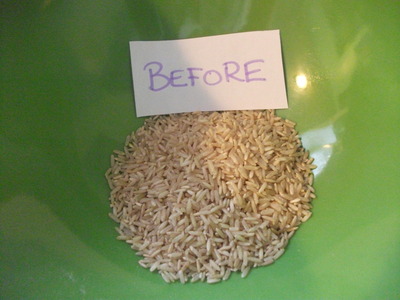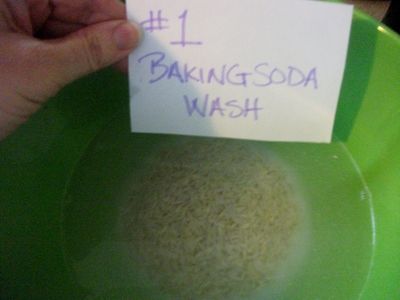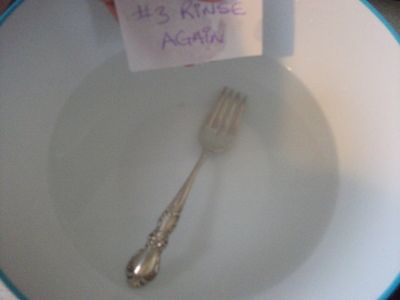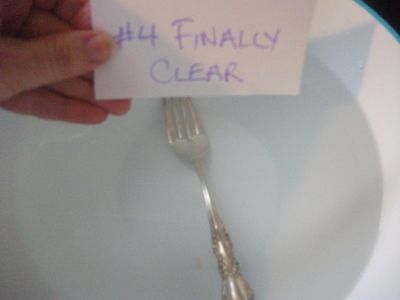If you're new here, you may want to subscribe to my RSS feed. Thanks for visiting!
Rice has long been at the top of the hierarchy in the prepper’s pantry. It’s inexpensive, a source of energy-boosting carbohydrates and can extend a humble serving of meat to turn it into a meal for a hungry family.
But lately, it seems that rice is falling from favor – and there are a few very valid reasons for that.
First of all, the pesticide load on conventionally grown rice is tremendous. PANNA (Pesticide Action Network of North America) identified more than 40 different pesticides on rice grown in California, with 15 of those pesticides on their “bad actors” list – which means that the pesticides have been proven in multiple studies to have negative effects on human beings and/or groundwater systems.
The website Whats On My Food? noted that the pesticides included those which were known to be carcinogenic, bee toxins, human reproductive and developmental toxins, neurotoxins and suspected hormone disruptors.
Rice that has been grown organically is not soaked in pesticides and fungicides from seed to package, like conventional rice. This is a vast improvement for the purity and nutritional value of a bulk rice purchase. White rice, when stored properly, has a far longer shelf life than brown rice, which is far more nutritious (and many find it much tastier as well).
Unfortunately, though, even organic rice is not the best thing to serve on a regular basis. Recent studies have shown that all rice, organic and conventional, has a high level of naturally occurring arsenic.
Arsenic is a metallic element that is toxic to multi-cellular life forms. There are two types of arsenic: inorganic and organic. Inorganic arsenic has not bonded with carbon and is a known carcinogen. Organic arsenic is found in seafood and is generally considered to be non-toxic. It is excreted through urine within about 48 hours of consumption.
Arsenic is taken into the rice from the soil, through the roots of the plant. Arsenic can get into the soil in many different ways, including the use of arsenic-containing pesticides. These pesticides can remain in the soil for up to 45 years after they were sprayed. Another source of arsenic in the soil is fertilizer made from chicken droppings – the commercial chicken feed has been found to have high levels of the toxin. When rice fields are deliberately flooded, the water-soluble arsenic in the soil is delivered to the roots of the plants.
Brown rice contains more arsenic than white rice – the arsenic accumulates in the hull, which is stripped during processing. The hull, however, contains most of the nutrients in the rice.
Arsenic can be toxic in both the short-term and the long-term. Everyone is familiar with the use of arsenic as a poison. According to the Mayo Clinic:
“Arsenic is perhaps the best known of the metal toxins, having gained notoriety from its extensive use by Renaissance nobility as an antisyphilitic agent…A wide range of signs and symptoms may be seen in acute arsenic poisoning including headache, nausea, vomiting, diarrhea, abdominal pain, hypotension, fever, hemolysis, seizures, and mental status changes. Symptoms of chronic poisoning, also called arseniasis, are mostly insidious and nonspecific. The gastrointestinal tract, skin, and central nervous system are usually involved. Nausea, epigastric pain, colic abdominal pain, diarrhea, and paresthesias of the hands and feet can occur.”
A study performed at Dartmouth University discovered the presence of arsenic in organic items sweetened with brown rice syrup at a level that was 17 times higher than the allowable amount of arsenic in drinking water. Rodale Press reported on the study:
Brian Jackson, PhD, the study’s author, said that it wasn’t just brown rice syrup that posed an arsenic threat, but any diet high in rice products, for instance, gluten-free diets in which rice flour is commonly used as a replacement for wheat. Rice is easily contaminated because arsenic is very similar to silica—a mineral rice needs in order to grow. “The rice does not discriminate between the source of arsenic,” Jackson notes. “If there is arsenic in the soil, whether from pesticides or naturally, or both, then it can be taken up by rice.”
…Lifetime, cumulative exposure to arsenic has been linked to cancers of the bladder, lungs, skin, kidney, nasal passages, liver, and prostate, but in a letter to Nature’s One, researcher Jackson told the company, “we don’t know what risks are associated with low level, limited-duration exposures.”
- White rice grown in Arkansas, Louisiana, Missouri, and Texas, which account for 76 percent of domestic rice, generally had higher levels of total arsenic and inorganic arsenic in our tests than rice samples from elsewhere.
- Within any single brand of rice we tested, the average total and inorganic arsenic levels were always higher for brown rice than for white.
- People who ate rice had arsenic levels that were 44 percent greater than those who had not, according to our analysis of federal health data. And certain ethnic groups were more highly affected, including Mexicans, other Hispanics, and a broad category that includes Asians.
- Reducing arsenic in food is feasible. We examined the efforts of two food companies, including Nature’s One, trying to tackle the problem and learned about methods being used to try to reduce arsenic in products.
- Based on these findings, our experts are asking the Food and Drug Administration to set limits for arsenic in rice products and fruit juices as a starting point.
The arsenic cannot be completely removed from the rice through washing or cooking methods – it’s there, inherent in the grain. It can be reduced. though, by up to 30% by washing the rice thoroughly before cooking it. The Asian cooking method of 1 part rice to 6 parts water, draining well before serving, as opposed to allowing your rice to absorb all the cooking liquid in the North American manner of cooking rice, is also helpful in reducing the presence of arsenic. These two steps also help to remove pesticides and antifungals that have been sprayed on the rice, as well as additives like talc and cornstarch which are sometimes added at the packaging plant in order for rice to have the clean white appearance we are so familiar with. Proper washing and cooking methods can significantly reduce the number of toxins in home-prepared rice.
*****
I performed a little rice washing experiment this morning because I was curious whether I could get any visible results. I used the same method as I always do for prepping rice. I used a conventionally grown brown rice for this. I don’t have a lab, so I can’t tell you exactly what I removed from the rice – but the visual tells me I do NOT want to skip this – ever!
I first soaked the rice in a baking soda rinse – 4 tbsp of baking soda to 2 cups of water.
Then I drained the rice into a white bowl to make it easier to see what came off in the soak. I ended up with a dirty, dingy looking water with little flecks of dirt in it.
I then washed out the bowl and dried it. I rinsed the rice into the bowl – this time I put a fork in the bottom of the bowl to illustrate how cloudy and dirty the rinse water was.
Again, I washed and dried the bowl and placed the spoon in the bottom.
After the 3rd rinse you could start to see the fork a little better.
I washed and dried the bowl and fork yet again.
By the time I rinsed it a 4th time, the water looked clean and clear.
My personal rules for rice have changed after doing the research for this article.
1.) I won’t buy commercial products made from rice, because I don’t know the process that has been used to clean the rice and remove pesticides, dirt and arsenic from it. This goes for organic as well as conventional rice products.
2.) Rice consumption will be limited to once per week, if that, in our household.
3.) I won’t ever eat rice at a restaurant again! I’ve seen how they dump rice right from the box into the pot.
4.) I’ll only buy organic rice because of the outrageous amount of pesticide usage.
In a prepping scenario, if your water is limited, rice is going to be the last thing you want to prepare because of the extensive washing and cooking water required. You don’t want to rely long-term on a food that contains something as toxic and carcinogenic as arsenic – the poison can build up in your system and cause serious problems. Look to other grains for your carbohydrates – consider quinoa, wheat berries, couscous, barley, and oats – none of these grains has the extensive pesticide load of rice and the natural arsenic levels are far lower.





















29 Responses
Thank you for posting this! I always try to buy organic rice, but never thought of washing it. Will do that from now on.
You’re very welcome! Thank you for reading!
~ D
I grew up eating rice just about every day for the first 25 years of my life with no ill effects. Mind you I grew up eating rice grown in the Caribbean so that might have something to do with it. Either way, neither I nor anybody I know has shown any signs of illness brought on by arsenic. Perhaps it is limited to the domestic rice brands?
many cultures eat rice much more regularly than most white bread americans, perhaps therefore more acclimated. the naturally occurring arsenic can be flushed more readily from the body without build up than say arsenic with a slew of toxic pesticides. the arsenic is coming from high concentrations in the soil i’d assume, not inherent in to all rice itself, or like tea that’s normally high in fluoride. a good alternative to rice in my house is quinoa.
Hi, Veggiemama – it’s awesome to see you here. 🙂
Yes, it’s taken up from the soil. Because rice is flooded each year the arsenic in the soil, which is water soluble, is released into the plant. Some of the research states that it can remain in the soil for at least 45 years, so even if arsenic-containing pesticides were used decades ago, it can still contaminate new crops of rice.
My daughter loves rice but we do not have it more than once per week. Quinoa is delicious and much more nutritious. We recently discovered wheat berries and I’ve been using them in recipes in place of rice. I like the texture far more than that of rice and it’s very economical.
Bear in mind that if you are not eating Emmer or Einkorn wheat berries or products, you are eating GMO wheat. Jovial foods has a good selection and I noticed that rareseeds.com has Emmer wheat berries to plant for your own! Love your insight as always 🙂
I believe what youre rinsing from the rice is mostly starch and not so much, dirt. I eat Basmati rice after rinsing 3 times and then soaking for 30 minutes…followed by a final rinsing. Arsenic has been added to chicken feed for at least the last 40 years (which is why I raise my own as close to organic as possible). All those droppings, as well as the chickens, are contaminated. I live in a Tyson town…I wont even get started on the nastiness of their ‘operations’.
Just an FYI, I wouldn’t EAT anything at any restaurant that uses boxed rice. Or boxed potatoes.
Most white rice is enriched, which means they have vitamins and minerals added that were removed in the process of removing the bran. If you wash the rice before cooking, or use the Chinese method of cooking, you loose the vitamin content of the rice.
After rice is hulled, it is coated with a bit of talc to help with storage and packaging. That is most of what you see when you wash rice. It won’t hurt anybody, but I usually wash it off. It isn’t dirt, and is similar in some ways to diatomaceous earth. Preppers using rice can mix 1 cup of food-grade diatomaceous earth (FGDE) into five gallons of rice (or any grain or legume) to prevent insects from eating it. My local feed store sells #50 bag of FGDE for $30. The stuff washes right off, has no odor or taste, and is completely harmless to people and animals.
can anyone tell me more about the diatomaceous earth powder, how is it safe to put on food. when I used to put in yard for fleas, it said do not breathe or walk on for 48 hours and til it had been watered in. curious I had never heard to be used with food interested! thank you all for all the wonderful info you all share!! learning everyday!
Thanks for reading!
You can buy food grade diatomaceous earth powder which is perfectly safe. 🙂
Daisy
skip thru the beginning as it is a link regarding horse worming, but it gives other benefits of D.E. just make sure it’s food grade…
http://thesoulofahorse.com/blog/no-more-poison-life-without-de-wormers/
sorry, forgot the link on original post.
Please, you could anytime send me tips to help the need of others towards healthy living.
I’m Filipino and we wash our rice thoroughly. I have friends here in the states that do not wash their rice. Gross.
People who eat rice and beans (as opposed to meat and potato- usual U.S. meal)…have a much higher life expectancy and don’t have all the health problems we do here in the US. So I don’t understand how this can come about… very confusing.
Recently, I had stomach pains after eating rice and beans and was concerned it was the rice so came to your website. It was just a plain bag of brown Uncle Bens’ rice, which we have been eating for a long time. (??!)
There has been a recent recall on Uncle Ben’s Rice.
Doesn’t water turn cloudy just by adding baking soda to it?
Are you washing it in fluoridated water? If so you successfully added even more toxins.
Well water. 🙂
I was wondering if the same goes for brown rice?
Did you wash your rice in regular tap water, purified water, or spring water? Those choices can also affect your rinse. My family uses purified water only. Tap water and spring water are almost the same (we had our bottled Zephyrhills water tested twice by two different companies on two different occasions).
What water did you use? 🙂
We used well water from our faucet.
How long would you recommended soaking the rice in the baking soda water?
15 minutes or so, Cher. 🙂
We always wash our rice, and the water always goes cloudy from the starch. So the comment seems odd to me. Basmati rice, because of the region and the protection of the NAME ‘Basmati’ is not subject to the usual host of pesticide, herbicide or insecticide covering. See article :- ‘Basmati free from chemical residues’ http://www.hindustantimes.com/amritsar/basmati-free-from-chemical-residues/article1-1274160.aspx Wheat however is almost always subjected to ‘Roundup’ which the World Health Organisation has finally concluded after 30 year study is carcinogenic, but definitely destroys gut bacteria in humans and is a posssible cause for diabetes, autism and Alzheimer’s, etc. Research it for yourself. Arsenic can be detoxed from the body by eating berries. Roundup effects are not so easily removed.
Excellent article, thanks! It should be mentioned most Asians don’t eat brown rice, and don’t eat white rice for nutrients–other than energy. WHite rice supplies one of the best ‘hits’ of low allergenic energy available. As I understand the research, US rice is contaminated with arsenic, Chinese rice with cadmium. Oh well, back to oatmeal and buckwheat.
At Costco is a brand that SUPPOSEDLY has the least arsenic available in rice ! It is LUNDBERG short -grain brown rice! I hope it is true! I do not eat rice in any restaurant, period!
Daisy you are the Best!